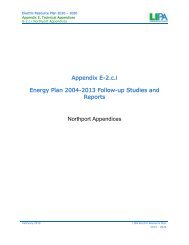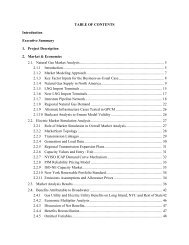Red Book - Long Island Power Authority
Red Book - Long Island Power Authority
Red Book - Long Island Power Authority
You also want an ePaper? Increase the reach of your titles
YUMPU automatically turns print PDFs into web optimized ePapers that Google loves.
2012 Edition <strong>Red</strong>book<br />
9.0 MOTORS AND CONTROLLERS<br />
9.1 GENERAL<br />
Before any large motors or special apparatus are installed, it is necessary to consult LIPA<br />
regarding the character and adequacy of the available service and the manner in which the<br />
equipment may be connected.<br />
9.2 MOTOR PROTECTION<br />
9.2.1 For the customer's protection, all motors and special apparatus should be<br />
equipped with suitable under voltage tripping devices to prevent sustained under<br />
voltage operation and equipment damage.<br />
9.2.2 All poly-phase motors shall be equipped with suitable protection to prevent single<br />
phase operation, improper rotation and excessive heating due to phase current<br />
unbalance.<br />
9.2.3 LIPA will not be responsible in any way for damage to customer's equipment due<br />
to the failure of the customer to provide adequate protection.<br />
9.3 MOTOR STARTING LIMITATIONS<br />
9.3.1 The starting of a motor on an electric circuit causes a momentary fluctuation of the<br />
circuit voltage each time the motor starts. Where this effect is pronounced, a<br />
visual disturbance or lighting flicker may be observed by the customer or other<br />
customers served from the same system. In extreme cases, the motor itself may<br />
have difficulty in starting. To minimize this problem, it is necessary to set limits<br />
upon the starting current permitted in any motor installation. These limits are<br />
designed to cover typical cases, and LIPA gives no warranty that particular<br />
conditions may not later require changes.<br />
9.3.2 Typical motor starting limitations based on motor start cycles not exceeding four<br />
starts per hour, are listed on the tables on pages 36 thru 38. Separate limitations<br />
are prescribed for conventional motorized equipment rated in BTU's per hour.<br />
Cases not covered therein should be referred to LIPA.<br />
9.3.3 All motors connected for operation at 120 or 240 volts which do not exceed the<br />
locked rotor starting current limitations as stated in tables 1 and 2, and are<br />
normally started four times per hour or less, may be connected directly to LIPA’s<br />
supply lines.<br />
9.3.4 Motors that do not comply with the locked rotor starting current limitations, or not<br />
covered therein, shall be discussed with LIPA. Specific inrush limitations will be<br />
supplied and will vary with the size, type, demand and location of service.<br />
9.3.5 When starting devices are used, the total current taken by the motor is not<br />
restricted by the rules but may have to be built up in steps, each of which does not<br />
exceed the maximum allowable motor starting current as stated by the company.<br />
When a step type starter is used, an appreciable time must be allowed on each<br />
step.<br />
9.3.6 When motors are started in a group instead of individually, the starting current<br />
limitations apply to the group and not to the individual motors.<br />
35






